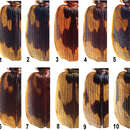Description
(
Anglèis
)
fornì da Zookeys
Body (Fig. 13) subconvex and small, 6.6–7.5 mm long. Dorsum black and shining, except for elytra. Pronotal pale pattern rather extensive along anterior and posterior margins. Elytral pale pattern (Figs 1, 2) fairly extensive as well, dark pattern entire, DMF moderately and subequally wide throughout, extended to interval 9 anteriorly and 8 posteriorly, with both front and back margins flexuose; its forward extension along side margin (conformable to DLS) occupying intervals 8 and 9; DSS rounded laterally, on intervals 1 to 5 before while on 1 to 4 behind, mostly angulate posterolaterally, with a straight or concave back margin; one to two inner intervals involved in DSF, often one anteriorly and two just before DMF. PHS entire, PHSi about 1/2 its length posterior to PHSe, the latter extended to interval 7 at humerus. Sometimes PHSe very narrowly separated from PHSi or surpassing it, in the latter case DMF constricted in interval 6. PAS front margin oblique. Ventral surface colored as in previous two species. Microsculpture sharp on elytra, absent from or almost invisible on head, extremely fine on pronotum and obsolete either before its middle or over greater part of disc, posterolateral region excluded; microsculpture a little sharper in female as being very superficial but traceable over head and/or pronotum.
Eyes large and convex, together with genae almost semicircular in outline; frons with 4–5, more often four, carinae on each side, outer ones long, inner not surpassing anterior supraorbital seta; sometimes carinae unilaterally amplified in number to six, irregular, or, otherwise, reduced to three, long ones. Vertex almost flat, neck-constriction barely traceable.
Pronotum 1.19–1.28 (mean 1.25, n=8) times as wide as head, 1.34–1.42 (mean 1.38) times as wide as long, basal margin slightly convex backwards or its almost straight medial part slightly produced, with lateral parts oblique towards and a little rounded at hind angles; anterior margin weakly sinuate, sides subsinuate to straight in basal half, mostly very shortly sinuate just before base, hind angles obtuse or very so, sharp to nearly indistinct. Front transverse impression obliterate, basal transverse impression shallow to moderately deep medially and deeper laterally, thus adjoining or forming a small, more or less deep, transverse pit at bottom of an almost reduced basal fovea, a very fine paralateral line traceable in basal third only. Basal border entire, anterior border very narrow, interrupted at middle. Rugosities rather dense and sharp, especially so posterolaterally, sparser and shallower in the middle of disc. Only reflexed side margin with large, sparse and shallow punctures combined with shorter rugosities.
Elytra flat, oblong-oval to reversely subovate, 1.44–1.57 (mean 1.51) times as long as wide, 1.57–1.71 (mean 1.63) times as wide as pronotum. Striae indistinctly crenulate, intervals subequally wide, flat or barely convex. Last abdominal sternite bisetose along apical margin in both sexes.
Penis as in Figs 17 and 23, its apical lamella subtriangular, more or less widely rounded at tip, the latter slightly curved upwards in lateral view. Female gonocoxite IX (Fig. 44) same as in Taridius ornatus sp. n.
- licensa
- cc-by-3.0
- drit d'autor
- Dmitri N. Fedorenko
- sitassion bibliogràfica
- Fedorenko D (2012) Notes on the genus Taridius Chaudoir, 1875 (Coleoptera, Carabidae, Lebiini), with descriptions of six new species from Vietnam ZooKeys 244: 67–89
- autor
- Dmitri N. Fedorenko

